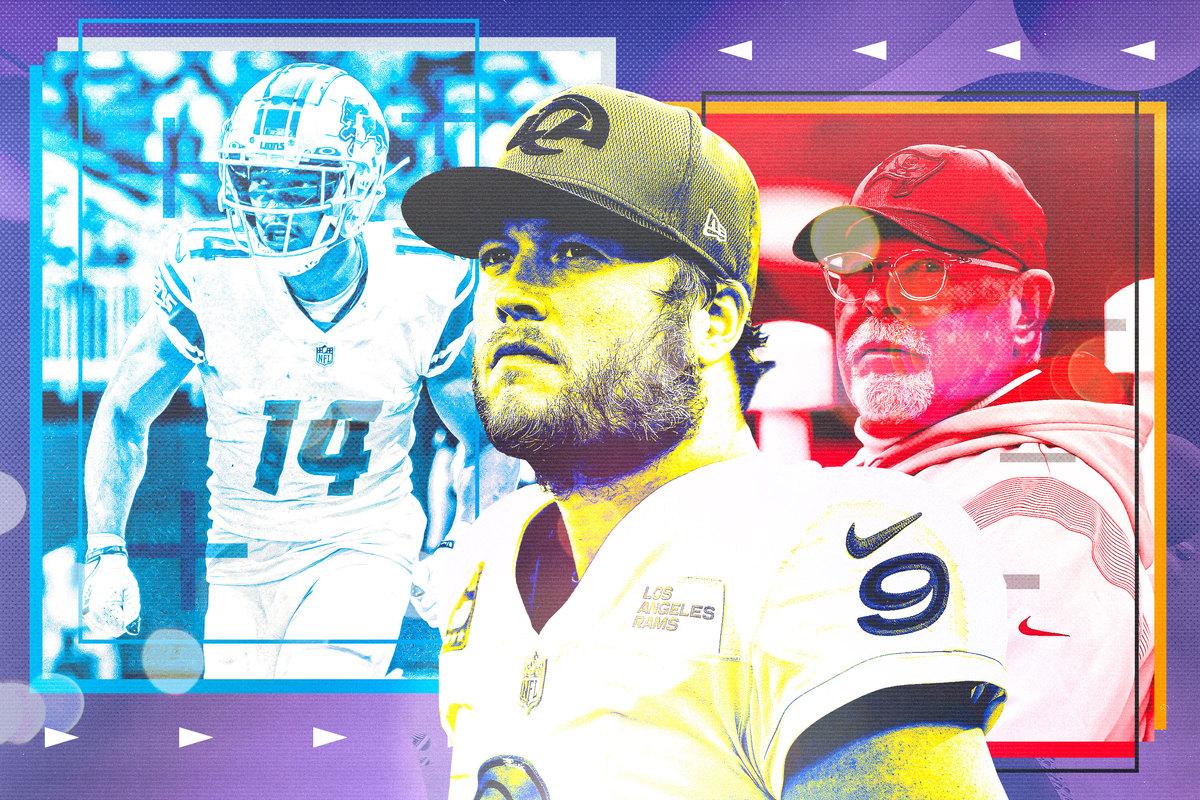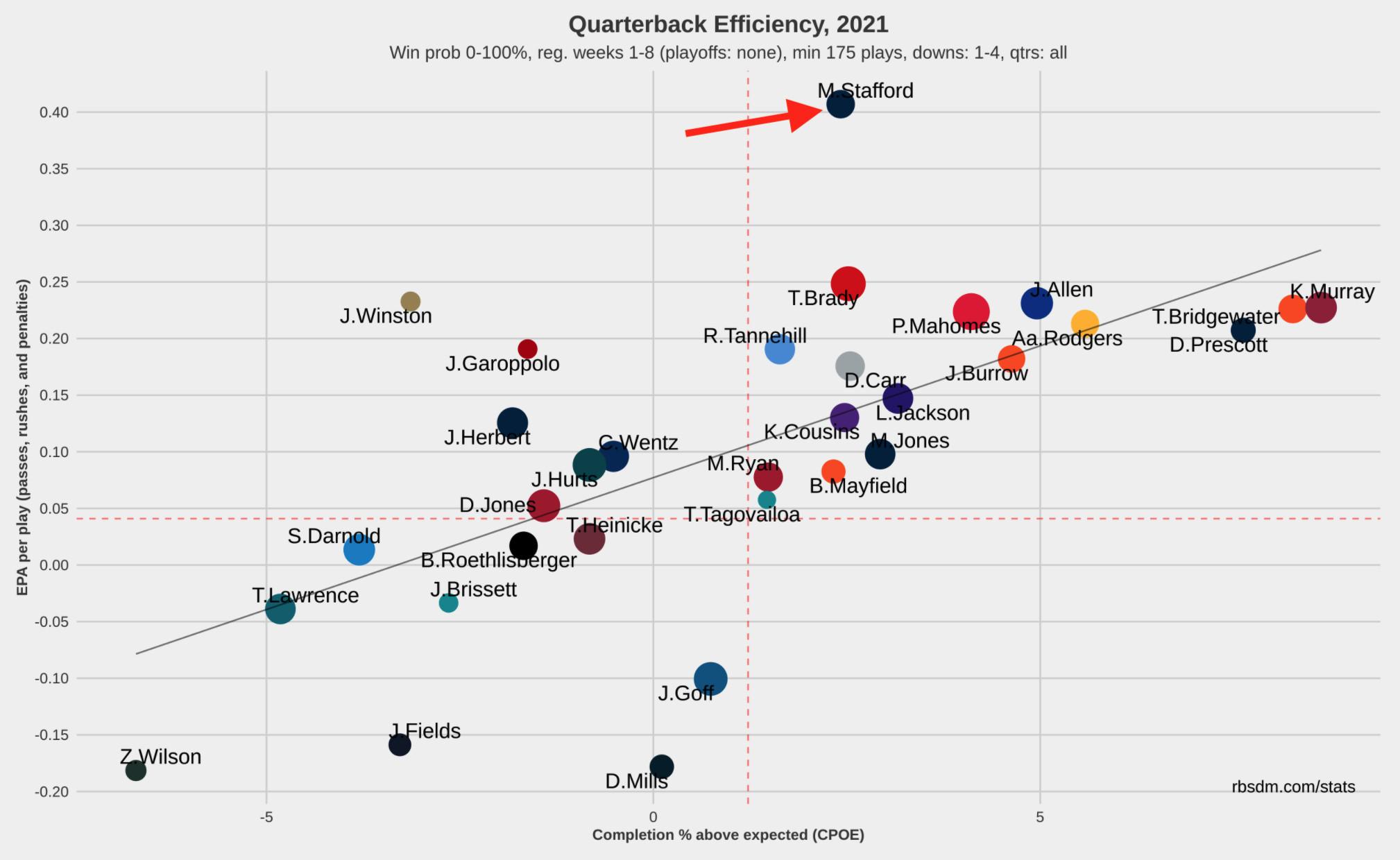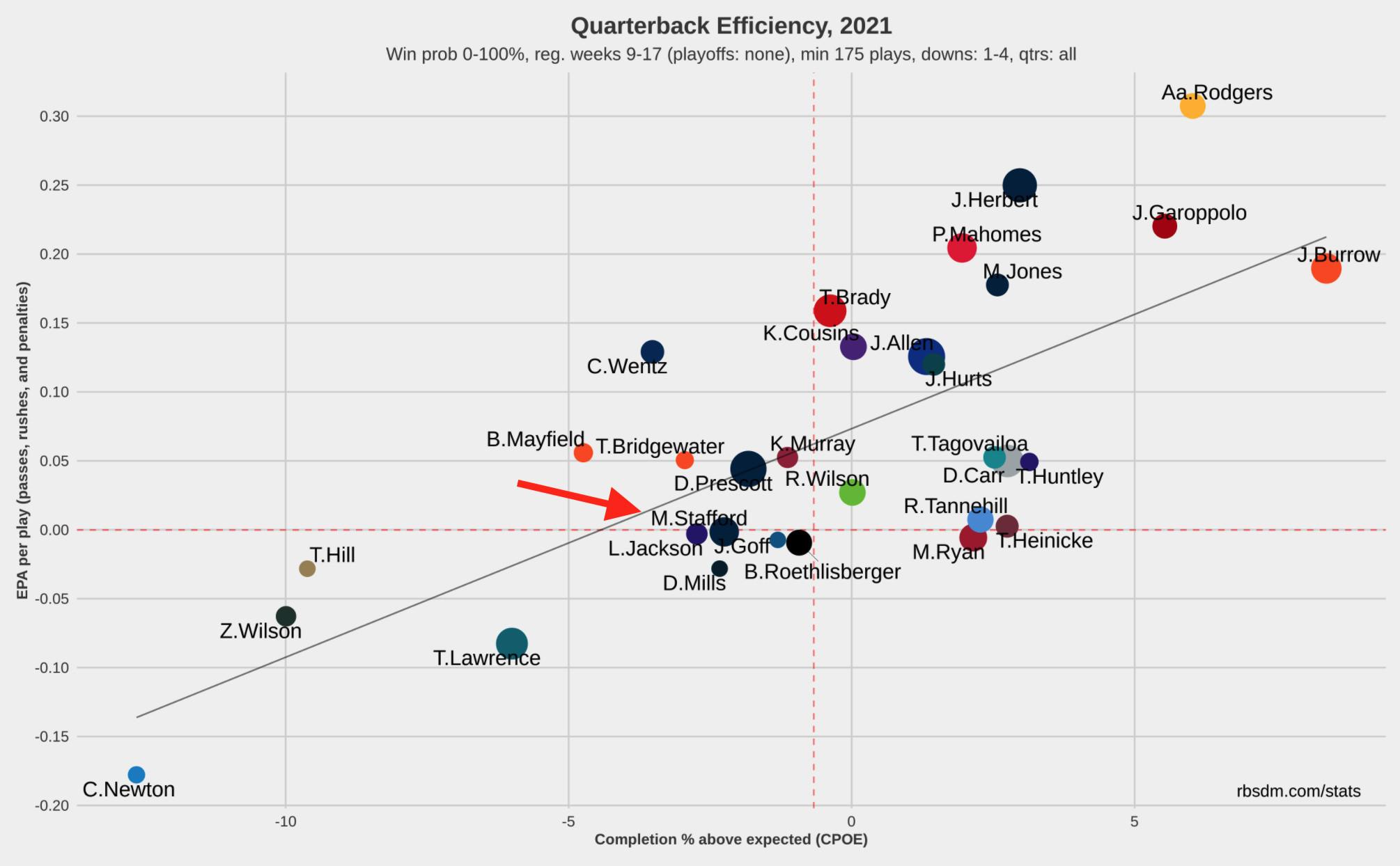
Another week of football means more shuffling at the top of these power rankings. The Packers move back into the top spot thanks to a 37-10 drubbing of the Vikings on Sunday Night Football, a win that locks them into the NFC’s no. 1 seed and ensures that the road to the Super Bowl in the conference runs through Green Bay. The Chiefs, meantime, drop slightly following a close road loss to the Bengals and the Bills move up after dispatching the Falcons. The banged-up Buccaneers sit at no. 4 after squeaking out a win over the Jets while the Rams and Bengals round out the NFL’s elite tier of teams heading to the regular season’s final week. With 17 weeks in the books, here are my updated power rankings.
The Top Shelf
1. Green Bay Packers (13-3)
2. Kansas City Chiefs (11-5)
3. Buffalo Bills (10-6)
4. Tampa Bay Buccaneers (12-4)
5. Los Angeles Rams (12-4)
6. Cincinnati Bengals (10-6)
The Buccaneers’ depth is being tested.
It’s a long-acknowledged reality that in the NFL, the best team doesn’t always win the Super Bowl. Frequently, the team that ends up hoisting the Lombardi is the one that got luckiest in avoiding injuries to key contributors down the stretch. The Buccaneers experienced that in 2020: Yeah, they had an undeniable force multiplier in Tom Brady at the helm for their Super Bowl run―but Tampa Bay also benefited from being incredibly healthy all season long, finishing 2020 with the fewest adjusted games lost (30.6) in the league, per Football Outsiders. The Buccaneers got by without defensive tackle Vita Vea for much of the season and lost Antonio Brown and Antoine Winfield Jr. for portions of the postseason, but their nucleus stayed mostly healthy, providing a massive advantage over other beat-up or reeling opponents.
This season, it’s a different story for Tampa Bay, which has been forced to weather injury storms on both sides of the ball. Early in the year, the Buccaneers had to scramble to find warm bodies to plug into its injury-decimated secondary, and that unit’s performance predictably suffered. Now, the team is struggling through a deluge of injuries on offense―a run of bad luck that will only be exacerbated by Brown’s dramatic mid-game departure on Sunday. Tampa Bay was able to eke out a 28-24 come-from-behind win over the lowly Jets, but the team’s less-than-impressive performance offered a sobering reminder that their star-studded offense is limping into the postseason.
Star receiver Chris Godwin is done for the year with a torn ACL, and there’s simply no way the team can replace his unique skill set. Whether we’re talking about Tyler Johnson, Scotty Miller, Breshad Perriman or Cyril Grayson (the latter of whom caught the game-winning touchdown on Sunday), no combination of the team’s depth receivers can replicate Godwin’s physical style or his tough run-after-the-catch talent. And with Brown gone, the team no longer has that quick-twitch route runner who can get open on demand. That puts the burden on Mike Evans, who’s just now returning from a hamstring injury himself, and 32-year-old Rob Gronkowski as Brady’s go-to guys. Evans is still a big red zone threat and Gronk remains a mismatch creator, but both have benefited this season by playing in an offense alongside Godwin and Brown. With opponents more able to focus on taking away Tampa Bay’s two main pass-catching threats, Brady’s passing efficiency may plummet.
Similarly, with lead running back Leonard Fournette (hamstring) and pass-catching specialist Giovani Bernard (knee) both on the injured reserve indefinitely, Tampa Bay has been forced to lean heavily on backup Ronald Jones (10 rushes, 26 yards on Sunday vs. the Jets) and third-stringer Ke’Shawn Vaughn (eight rushes, 31 yards) in the ground game. Neither has shown the consistency or veteran reliability of Fournette and Bernard, nor do either factor into the passing game―and now both Jones (ankle) and Vaughn (ribs) are dealing with injuries of their own, too. The only healthy running backs left on the roster are Le’Veon Bell (whom the team signed on December 22) and special teamer Kenjon Barner. With so much attrition happening on offense—hell, even head coach Bruce Arians is nursing an Achilles injury at this point, as Jay Glazer reported this week, and if it gets worse his ability to coach from the sideline could be an issue—Brady will have to put that group on his back. Ultimately, Brady is so good, he alone may be enough. But this team is beat up at the worst time.
The Rams need to snap out of this offensive slump.
Another truism for the NFL playoffs is that teams just have to get hot at the right time. The Rams are doing just the opposite right now. A group that looked like an unstoppable juggernaut early in the year under new quarterback Matthew Stafford has turned into something hovering around average in most traditional metrics. The splits are telling: Through the first eight weeks, the Rams were averaging 30.6 points per game (fifth), had scored 29 touchdowns (third), and were averaging 6.5 yards per play (tied for first) with just seven total turnovers (tied for seventh). They were 7-1 in that stretch. In the nine weeks since, though, L.A.’s offense has averaged 23.9 points per game (13th), scored 20 touchdowns (15th), averaged 5.7 yards per play (10th), and turned the ball over 14 times (tied for 24th). They’re 5-3 in that stretch.
Those turnovers have been the most glaring and obvious issue for a unit that’s slumped during the second half of the year, and Stafford’s penchant for mystifying decision–making showed up again in the team’s 20-19 win over the injury-debilitated Ravens. Stafford had three rough turnovers in the victory, tossing his league-leading fourth pick-six late in the first quarter before throwing another interception in the second quarter and a lost fumble to begin the second half. Stafford isn’t the only culprit behind the team’s problems, of course, and head coach Sean McVay was quick to point out that the pick-six was the result of a mix-up on the routes. But Stafford is the face of that unit, and whether he’s still playing through a handful of painful injuries or not, he will bear the brunt of the blame.
Stafford’s early-season vs. late-season splits pretty closely mirror those of the entire offense. Through his first eight games with the Rams, he threw 22 touchdowns to just four interceptions while averaging 9.1 yards per attempt and 310 yards per game with a 118.0 passer rating. He was lapping the field in expected points per play in that stretch and had compiled the top EPA+CPOE composite in the NFL, per rbsdm.com, among players who’d logged 175 plays. It had seemed as though the Rams had hit a home run in trading for Stafford.

Stafford’s performance through the past eight games has taken the shine off of some of those early-season narratives. He’s thrown 16 touchdowns and 11 picks with two lost fumbles in the second half of the season, averaging 7.3 yards per attempt and 271 passing yards per game with a 90.1 passer rating. He’s been better than Jared Goff, at least in EPA+CPOE composite (he ranks 22nd in that metric among players with 175 plays), but a preponderance of outright terrible throws has to have Rams fans concerned.

The good news, of course, is that despite another rough start from Stafford on Sunday, he did finish the game strong, completing his final 15 passes and leading L.A. to a come-from-behind win. In fact, Stafford has, despite his issues, been a strong fourth-quarter passer all year, notching a league-best EPA per play in that frame. If the veteran quarterback can cut out most of the head-scratching throws and take better care of the ball in the early parts of games, the Rams could right the ship on offense and get back to their buzz saw ways. They need to do just that if they hope to make noise in the playoffs.
The Contenders
7. Arizona Cardinals (11-5)
8. Dallas Cowboys (11-5)
9. Tennessee Titans (11-5)
10. New England Patriots (10-6)
11. Indianapolis Colts (9-7)
12. San Francisco 49ers (9-7)
13. Philadelphia Eagles (9-7)
14. Los Angeles Chargers (9-7)
The Titans are in the AFC’s catbird seat.
The Titans took care of business and then some in Sunday’s 34-3 win over the previously red-hot Dolphins, snapping Miami’s seven-game win streak while dominating the game in all three phases. Tennessee neutralized Tua Tagovailoa with a devastating pass rush, controlled the game on offense with a clock-eating rushing attack behind D’Onta Foreman, and won the field-position game with a handful of pin-them-deep punts from Brett Kern. It was a zero-doubt victory from the very beginning and a win that gives Tennessee the chance to become one of the weirdest no. 1 seed teams in recent history.
The Titans will get the no. 1 seed if they win next week against the Texans. That’s no sure thing, of course, considering Tennessee lost to Houston earlier this year. But a no. 1 seed Titans team would be a perfect representation of the parity we’ve seen in the conference this season: They’re an injury-decimated squad that has kept finding ways to win despite being forced to roster an NFL-record 88 different players throughout the season. They’re a relatively boring team to watch with a grind-it-out, slow-paced strategy; an aesthetically-grotesque style that’s been rendered near-unwatchable at times as the team has dealt with the losses of Derrick Henry, A.J. Brown, and Julio Jones for big chunks of the season. They’re an underwhelming group when it comes to advanced metrics, too, and came into this week ranked 20th in Football Outsiders’ DVOA. And they’d be the first five-loss team to secure the top seed in either conference since 2002. The Titans just aren’t what no. 1 seeds typically look like.
But that’s fine, because Tennessee has embraced the winning ugly thing. On defense, they rush the passer with a suffocating, playmaking front and pick passes off with an opportunistic secondary. And offensively, they drag opponents down into the mud with a physical, run-centric approach. They grind opposing defenses down with an early-down run rate (55 percent) that’s topped by only the Eagles. The rushing offense is not as explosive without Henry, naturally, but they’ve managed to recreate some semblance of an offense with Foreman carrying the load. And when the team needs quarterback Ryan Tannehill to make a big throw in a high-leverage situation, he’s answered the call often enough.
The Titans are a gritty, stubborn squad that’s taken on the personality of head coach Mike Vrabel. And crucially, they’re getting relatively healthy at just the right time. Brown is back after missing a stretch of games to a chest injury. Jones is off the COVID list and could be close to returning to the field after injuring his hamstring. And Derrick Henry could be back as soon as next week. If Tennessee can keep dominating the line of scrimmage on defense and get their trifecta of offensive stars onto the field at the same time, the Titans will have a real shot at making a run to the Super Bowl.
The Muddled Middle
15. Las Vegas Raiders (9-7)
16. Baltimore Ravens (8-8)
17. Miami Dolphins (8-8)
18. Pittsburgh Steelers (8-7-1)
19. Cleveland Browns (7-9)
20. New Orleans Saints (8-8)
21. Minnesota Vikings (7-9)
22. Denver Broncos (7-9)
23. Chicago Bears (6-10)
24. Seattle Seahawks (6-10)
25. Atlanta Falcons (7-9)
The Raiders still control their own destiny.
This Raiders season has been a chaotic one, but Derek Carr has quietly kept his team afloat. The 30-year-old veteran hammered that point home in the team’s critical 23-20 win over the Colts on Sunday, rallying his team on a pair of clutch fourth-quarter scoring drives to keep Las Vegas’s playoff hopes alive.
With his team trailing 17-13 early in the fourth quarter, Carr and the Raiders offense faced a fourth-and-2 from the Indianapolis 11-yard line. He dropped back to pass, moved to his right, and threaded the needle to Hunter Renfrow in the end zone.
The Colts tied the game back up at the two-minute mark of the quarter to set up the decisive final drive for Las Vegas. Carr went to work, engineering a 10-play, 60-yard scoring drive that was defined by a critical conversion on third-and-10. Dropping back from the Indianapolis 48-yard line, Carr scanned to his left, avoided the free-rushing Darius Leonard, stepped up, and delivered a beautifully placed teardrop on the run to Renfrow to pick up 24 yards.
That play set up the game-winning field goal by Daniel Carlson and helped the Raiders maintain control of their destiny in the postseason picture. Las Vegas now draws a winner-take-all matchup with the Chargers next week on Sunday Night Football. This Derek Carr–led team is far from perfect, but they’ve done everything they needed to do over the past three weeks to give themselves a chance for a playoff berth. Now they need to go finish it.
There’s Always Next Year
26. New York Jets (4-12)
27. Washington Football Team (6-10)
28. Houston Texans (4-12)
29. Carolina Panthers (5-11)
30. Detroit Lions (2-13-1)
31. New York Giants (4-12)
32. Jacksonville Jaguars (2-14)
Amon-Ra St. Brown a silver lining for lost Lions season.
The Lions are mired in a mostly depressing rebuilding year, but the emergence of a mid-round rookie receiver could have big-time implications for Detroit’s future. A fourth-rounder out of USC, Amon-Ra St. Brown has been an absolute revelation for the Lions during the past five weeks, a stretch of games that coincides with the coaching staff’s decision to make him a full-time contributor. After starting the season as a part-time slot receiver for Detroit, St. Brown has expanded his route running and is now lining up all over the formation for the Lions, including reps on the outside and even a few in the backfield à la Deebo Samuel―like this play from Sunday when he took a draw for 26 yards and a score.
St. Brown racked up eight catches for 111 yards and a touchdown in the 51-29 loss to the Seahawks, adding 23 yards and a touchdown on the ground. He’s been the go-to pass catcher for the Lions going back to Week 13, a stretch in which St. Brown trails only Cooper Kupp in catches (43) while ranking seventh in receiving yards (451) and tied for fourth in touchdowns (four). He’s the first rookie receiver ever with eight-plus catches in five consecutive games, and while Ja’Marr Chase, DeVonta Smith, and Jaylen Waddle have gobbled up more attention, St. Brown has emerged as one of the best receivers in his rookie class. The 6-foot, 197-pound playmaker gives the Lions a foundational piece to build around.

